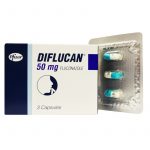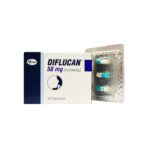Can I Take Fluconazole While Breastfeeding?

Available data indicates that about three out of every four women will have at least one yeast infection in their lifetime, according to American Family Physician. Up to 45 percent will get two or more infections.
During pregnancy, Candida (and the infections it causes) is even more common. According to one study, about 20 percent of women have Candida yeast in their vagina normally. That number goes up to 30 percent during pregnancy.
Candida is a naturally occurring organism. It doesn’t usually cause any problems, but if it multiplies uncontrollably, thrush can occur. In women who are breastfeeding, thrush can lodge in the nipples, areolas, and breasts, causing significant pain. This may be more likely to occur if your nipples are cracked and open.
According to the CDC, breast milk is designed to provide the appropriate amount of calories and optimal nutrition to support the growth and health of the infant. However small amounts of what you’re eating and drinking including prescription medication, over-the-counter drugs, and supplements can pass to your baby through your breast milk.
Certain drugs such as alcohol, some illegal drugs, and some prescription and over-the-counter medications are known to cause problems if taken while you are breastfeeding. Knowing which drugs that are safe to take can provide relief and prevent complications for your breastfeeding child.
What is fluconazole?
Fluconazole is a medication used to treat serious fungal or yeast infections, including vaginal candidiasis, oropharyngeal candidiasis (thrush, oral thrush), esophageal candidiasis (candida esophagitis), other candida infections (including urinary tract infections, peritonitis [inflammation of the lining of the stomach], and infections that may occur in different parts of the body), or fungal (cryptococcal) meningitis.
Fluconazole is also used to prevent candidiasis in patients having bone marrow transplants who receive cancer or radiation treatment. Fluconazole is in a class of antifungals called triazoles.
How it works
Fluconazole belongs to a class of drugs called triazole antifungals. A class of drugs is a group of medications that work in a similar way. These drugs are often used to treat similar conditions.
Fluconazole works by blocking the ability of the fungi Candida and Cryptococcus to reproduce. For people with infections from these fungi, this drug helps to get rid of the infection. For people at higher risk of candidiasis, it helps to prevent infection.
How should fluconazole be used?
Fluconazole comes as a tablet and a suspension (liquid) to take by mouth. It is usually taken once a day, with or without food. You may need to take only one dose of fluconazole, or you may need to take fluconazole for several weeks or longer. The length of your treatment depends on your condition and on how well you respond to fluconazole. Follow the directions on your prescription label carefully, and ask your doctor or pharmacist to explain any part you do not understand. Take fluconazole exactly as directed. Do not take more or less of it or take it more often than prescribed by your doctor.
Your doctor may tell you to take a double dose of fluconazole on the first day of your treatment. Follow these directions carefully.
Shake the liquid well before each use to mix the medication evenly.
You should begin to feel better during the first few days of treatment with fluconazole. If your symptoms do not improve or get worse, call your doctor.
Continue to take fluconazole until your doctor tells you that you should stop, even if you feel better. Do not stop taking fluconazole without talking to your doctor. If you stop taking fluconazole too soon, your infection may come back after a short time.
Can I take fluconazole while breastfeeding?
Yes, available data indicates that the use of fluconazole during breastfeeding is safe and will not cause any unwanted side effects or complications because amounts excreted into breastmilk from the nursing mother are less than the neonatal fluconazole dosage.
In addition, fluconazole is also used in the treatment of fungal diseases in infants and has a good safety profile. Therefore, there is no need to interrupt breastfeeding when a mother is treated with fluconazole.
Fluconazole side effects
The more common side effects of fluconazole depend on how much of the drug you need to take. These side effects can include:
• changes in the way food tastes
• diarrhea
• dizziness
• headache
• nausea or upset stomach
• severe rash in people with lowered immunity
• stomach pain
• vomiting
If these effects are mild, they may go away within a few days or a couple of weeks. If they’re more severe or don’t go away, talk with your doctor or pharmacist.
Serious side effects
Call your doctor right away if you have serious side effects. Call 911 if your symptoms feel life-threatening or if you think you’re having a medical emergency. Serious side effects and their symptoms can include the following:
• Liver damage. Symptoms can include:
o yellowing of your skin or the whites of your eyes
o dark urine
o light-colored stools
o severe skin itching
o vomiting or nausea
• Severe rash in people with acquired immunodeficiency syndrome (AIDS) or cancer. Symptoms can include:
o skin peeling
o severe rash
• Torsades de pointes (a life-threatening heart rhythm condition). Symptoms can include:
o feeling like your heart is skipping a beat (palpitations)
o fast, irregular heart rate
o dizziness
o fainting
o seizures
• Adrenal gland problems. Symptoms can include:
o muscle weakness
o belly pain
o fatigue
o loss of appetite
Fluconazole may interact with other medications
Fluconazole oral tablet can interact with other medications, vitamins, or herbs you may be taking. An interaction is when a substance changes the way a drug works. This can be harmful or prevent the drug from working well.
To help avoid interactions, your doctor should manage all of your medications carefully. Be sure to tell your doctor about all medications, vitamins, or herbs you’re taking. To find out how this drug might interact with something else you’re taking, talk with your doctor or pharmacist.
Examples of drugs that can cause interactions with fluconazole are listed below.
Drugs that should not be used with fluconazole
There are certain drugs that you should not use with fluconazole. When used with fluconazole, these drugs can cause dangerous effects on your body. Examples of these drugs include:
• Terfenadine. When used with fluconazole at doses of 400 mg or higher, this drug can cause a life-threatening heart rhythm condition called torsades de pointes.
• Pimozide, clarithromycin, erythromycin, ranolazine, lomitapide, donepezil, voriconazole, and quinidine. When used with fluconazole, these drugs can cause a life-threatening heart rhythm condition called torsades de pointes.
Drugs that increase the risk of side effects
Taking fluconazole with certain drugs raises your risk of side effects from those drugs. Examples of these drugs include:
• Antidepressants, such as citalopram, escitalopram, and paroxetine. Taking fluconazole with these medications raises your risk of a life-threatening irregular heart rhythm condition called torsades de pointes.
• Antipsychotic drugs, such as chlorpromazine, haloperidol, and ziprasidone. Taking fluconazole with these medications raises your risk of a life-threatening irregular heart rhythm condition called torsades de pointes.
• Carbamazepine. Increased side effects include nausea, vomiting, unsteadiness, low blood cell counts, severe rash, heart failure, and liver failure.
• Certain calcium channel blockers, such as nifedipine, amlodipine, verapamil, and felodipine. Increased side effects include low blood pressure, dizziness, confusion, and headache.
• Certain statins, such as atorvastatin and simvastatin. Increased side effects include muscle pain and weakness and raised levels of creatinine in your blood.
• Cyclosporine, tacrolimus, and sirolimus. Increased side effects can include kidney damage. Your doctor will check your blood for signs of kidney damage while you’re taking fluconazole. If you show signs of kidney damage, your doctor may lower your doses of these drugs or stop them completely until your treatment with fluconazole is done.
• Diabetes drugs such as glyburide and glipizide. Increased side effects can include low blood sugar. This causes symptoms such as sweating and chills, shakiness, fast pulse, weakness, hunger, and dizziness.
• Heart rhythm drugs, such as amiodarone and dofetilide. Taking fluconazole with these medications raises your risk of a life-threatening irregular heart rhythm condition called torsades de pointes.
• Pain drugs, such as methadone and fentanyl. The levels of these drugs may be increased in your body when taken with fluconazole. Increased side effects include slower breathing, confusion, and drowsiness.
• Phenytoin. Taking this drug with fluconazole can cause trouble with coordination, slurred speech, and confusion. Your doctor will measure blood levels of phenytoin while you’re taking fluconazole. It’s possible that your doctor will decrease your dose of phenytoin while you’re taking fluconazole.
• Theophylline. Taking this drug with fluconazole can cause muscle cramps, headaches, low blood pressure, and seizures. Your doctor will measure blood levels of phenytoin while you’re taking fluconazole.
• Warfarin. Increased side effects can include bruising, nosebleeds, and blood in your urine or stools.
• Zidovudine. Increased side effects can include headache, tiredness, loss of appetite, nausea, and vomiting.





